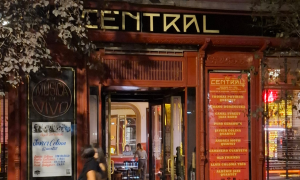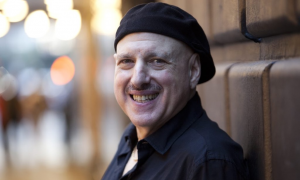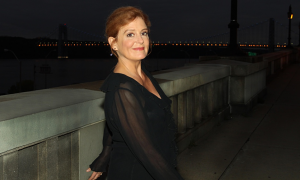Home » Jazz Articles » The Jazz Life » Indecent Heroes and All That Jazz
Indecent Heroes and All That Jazz

Perhaps the best thing that can come from the fall of people like Cosby and Weinstein, Rose and perhaps Chuck Close is that we’re forced to reexamine our world, and create new art and music that reflects how we have grown as a society, but without abandoning the artistic observations of those who have come before.
Some context: Museums around the world are wrestling this year with the National Gallery of Art in Washington's decision in January (2018), to indefinitely postpone a Chuck Close exhibition because of allegations of sexual harassment against him. He has called the allegations "lies." Nothing necessarily new there. Close is considered the most important portrait artist of the late 20th Century, however. He basically reinvented it, making him a kind of Louis Armstrong or John Coltrane of portraiture.
The postponement has raised difficult questions in the art world about what to do about Chuck Close paintings and photographs held by museums like the Metropolitan Museum of Art in New York, the Tate in London and the Pompidou in Paris, and whether the work of other artists accused of questionable conduct needs to be revisited. Jock Reynolds, the director of the Yale University Art Gallery, told the New York Times) "He innovated how the portrait could be seen. That is a creative force that's got to be reckoned with and will endure."
Lest you think this is guys closing ranks to protect other guys, the Times piece also quoted Sheena Wagstaff, the Met's chairman for Modern and contemporary art.
"By canceling an exhibition or removing art from the walls, a museum is creating an understanding of an artist's work only through the prism of reprehensible behavior... If we only see abuse when looking at a work of art, then we have... stripped [art] of its intrinsic worth..."
I grew up in an era that predated Watergate and the Pentagon Papers. Cultural cynicism was considered edgy and radical and came from people like Lenny Bruce, Dick Gregory, and the British satirical magazine Private Eye, all of which I eagerly embraced. But it was balanced by iconic hero worship in actors like Jimmy Stewart, John Wayne, Steve McQueen, and Katherine Hepburn that seemed (in a wobbly way) to point us in the right direction as individuals, even when the behavior of those heroes does not stand much close scrutiny. (It was still too early for most jazz fans, for example, to know or care who Mary Lou Williams was. Her rediscovery would come some years later.)
I remember going to Ronnie Scott's Club in London, in the mid-1970s, and watching Stan Getz's band which included guitarist Chuck Loeb. It was Chuck's turn to take a solo. As he played, Getz walked over and stood an arm's length from him and blew cigar smoke into his face! Loeb complained as only a musician can. He turned up even louder, and went from jazz mode to heavy metal.
Ronnie Scott famously told friends he got his slipped disk bending over backwards to please Stan Getz. He would introduce him to audiences by saying, "Ladies and gentleman, whatever Stan wants—Stan Getz."
Jazz historian Digby Fairweather said about Bix Beiderbecke (Jazz: The Rough Guide, (Penguin)) that he was, ..."a man of enormous talent but meager character or self-discipline, and his creative despair, induced by technical inadequacy and lack of vision, made him take refuge in alcohol."
Journalist Miles Kingston in the Independent newspaper interviewed Pete King (the guy who ran Ronnie Scott's for years, not the saxophonist of similar name). Pete said, "You can generally tell the character of saxophonists from their tone. The rougher they sound, the sweeter they are in real life. The guys who play with a gritty, attacking tone, as hot as you like, are always the nice ones. It's the ones who sounds so lush who turn out to be the ruffians. Remember Don Byas? Lovely sweet tone? Seductive sound? When he came to the club, he kept pulling knives on people. And who do you think is the most sweet-sounding tenor saxophonist of all?"
"I thought. Ben Webster? When he played slowly, he was ravishing. But when he played fast, he had a quite different, scorching tone. Obviously a split personality there. Mr. Nice and Nasty in the same person. So it had to be... Stan Getz! Stan Getz had the most voluptuous sound of any tenor player that ever lived, silky and strong, totally mesmeric.
"Stan Getz," I said. He nodded.
"He was without doubt the most unpleasant and disagreeable person who ever played at Ronnie Scott's. Everyone loathed him."
A tenor saxophonist friend told me years ago, when I asked him how it was that someone like Stan Getz could play so beautifully and be so ugly as a person, that most sax players would give their right arms to play phrases that Getz threw away. His creative beauty was a personification of his arrogance and insecurity as well as his natural talent, a contradiction that itself almost defies embracing. I like to think it's an example of nearly everyone possessing something positive in them—even, in the end (spoiler alert), Darth Vader.
The thing about Cosby as a creative artist is that the Cosby Show was instrumental in helping middle class African-Americans both be seen and see themselves as part of mainstream America in a way that had not happened previously. This is not a small thing. More than most, Cosby's fall has raised for me how a creative person of conscience deals with art by artists who turn out to be jerks. (Ezra Pound, T.S Elliot, Degas, Wagner, and Virginia Woolf were all self-avowed anti-semites; Norman Mailer famously stabbed his wife in the chest and nearly killed her; Caravaggio did actually murder someone; Michelangelo was such an arrogant jerk his brother called him stingy and friendless; Jean Genet was a thief; Byron committed incest; Flaubert paid for sex with boys... the list goes on and on.)
Charles McGrath, in a New York Times op-ed piece, commented that an artist's "badness" or "goodness" is a moral judgment, but the goodness and badness of their work is decided on aesthetic merit. McGrath went on, "The conductor Daniel Barenboim, a Jew, is a champion of Wagner's music, for example, and has made a point of playing it in Israel, where it is hardly welcome. His defense is that while Wagner may have been reprehensible, his music is not."
So, how best to guide my teenage son who wants to have a life as a creative person? How to suggest to him how to differentiate between the art/music someone makes, and the possibility that as role models many of his artist heroes are less than savory? The best I've come up with so far is that the message, if it is honorable, should not be contaminated by a dishonorable messenger. The problem for musicians and artists is that to do it well, of necessity we are so wrapped up in ourselves and our work it's a challenge and a distraction to think and care about how we interact with other people.
That leads to another question: can "good people" make great art?
I am under the perhaps delusional opinion that we are all flawed to some degree, and creating art is the artist's unconscious way of working through that. We do what we do partly by choice, but largely because we are driven to do it.
I have a close friend who is considered one of the world's great jazz players. When he was younger he got into a lot of confrontations and arguments with people, and maybe one or two actual fights. If it wasn't for discovering music as a teenager, he once told me, "I would have been lost. It gave me a focus, and a path to follow that I continue to follow to this day. Without it I'd probably be dead by now. Or in jail. Music saved me, there is no doubt." My friend added, "It satisfied my every need, musically, spiritually, even sexually in terms of the women I met through playing jazz."
And it was this friend who also reminded me that Gerry Mulligan was not one of the nicest people in the world, and that Harry Allen had been a staunch conservative (which actually doesn't make him a "bad" person, just an outlier, and undermines the concept that conservatives can't swing).
Artists are only here for a short time. The work that outlives them somehow takes on its own life. In that sense, it should be no more tainted with its creator's faults than children of "bad" people should be. It's not your fault what your mother or father did or said. Should we really call Romano Mussolini, the Italian jazz pianist, to account for his father, Benito's sins? (Chet Baker is reported to have said to him when they first met, "Sorry to hear about your dad.") Mein Kampf speaks for itself; we don't need to know it was created by Adolf Hitler to condemn it.
F. Scott Fitzgerald once said, "show me a hero and I'll write you a tragedy." The tragedy may be that heroes, at least for a while as we grow, fill a void in our souls. How else to grow as an artist except on the shoulders of those who have come before, warts and all? Without heroes it feels like we will all be lost or somehow permanently diminished. How distressing then, to discover those heroes are often flawed people.
I guess the questions we wrestle with, knowingly or not as creative people, are: Is decency an automatic disqualifier for making great art? Where is the line on indecency? Would I want my son or daughter to be influenced by the lifestyles and choices of these flawed heroes? And, how can I deny my children access to art that has shaped and is shaping who we have been, and are becoming as a society, even when it is created by murderers, rapists, thieves, bigots, abusers and the rest?
And here's one more contradiction about great art and bad artists. John Ford was not one of the nicest people in the world, particularly to John Wayne, who he turned into an icon of American "manliness"—whatever that means. Ford was a closet gay who was never comfortable with who he was or that anyone could know about it. And yet ... In his Atlantic magazine piece How John Wayne Became a Hollow Masculine Icon, Stephen Metcalf tells this story: In 1950, Cecil B. DeMille led a witch hunt against the directors' guild, attempting to purge it of members who were suspiciously left-wing (and Jewish). His main target was its chair, Joseph Mankiewicz. At a meeting at the Beverly Hills Hotel, DeMille said his piece, after which Ford, who hadn't yet said a word, stood up, turned to the stenographer, and said, "I'm John Ford. I make Westerns."
He addressed the gathering: "I don't think there is anyone in this room who knows more about what the American public wants than Cecil B. DeMille—and he certainly knows how to give it to them. In that respect I admire him." Then he added, "But I don't like you, C.B. I don't like what you stand for, and I don't like what you've been saying here tonight. Joe has been vilified, and I think he needs an apology." Ford, who was never bigger than his role, concluded by saying, "I believe there is only one alternative, and I hereby so move: that Mr. DeMille and the entire board of directors resign and that we give Joe a vote of confidence. And then let's all go home and get some sleep. We've got some pictures to make tomorrow." The motion carried the day.
Real art, whether it's musical or visual often challenges us. Apart from a couple of tunes like "'Round Midnight," it took a long time for Monk to become part of the mainstream, and Lennie Tristano and Warne Marsh are still considered by many to be fringe musicians. There is an element of courage in standing up for challenging art that highlights things or people we are uncomfortable with. To me, genuine art is about flawed people bringing both their talents and insights to observations of the world around them in an effort to understand and digest it. Deliberately or not we then shine a light on what we've seen for others through our creations. That does not mean we should make ugly things palatable. It means, hopefully, that we get to see something for what it really is, but through a lens of compassion. The compassion is an affirmation of existence, the thing art/music tries to help us find.
I think art is about finding grace in the chaos around us, helping ourselves and others find a place in a world we often feel we are disconnected from and frustrated by. Perhaps the best thing that can come from the fall of people like Cosby and Weinstein, Rose and perhaps Close is that we're forced to reexamine our world, and create new art and music that reflects how we have grown as a society, but without abandoning the artistic observations of those who have come before. Because they are messages from our heroes we need to preserve, for us to take care, lest we end up as they did...
Photo credit: Pinkasem Muisri on Unsplash
Tags
PREVIOUS / NEXT
Support All About Jazz
 All About Jazz has been a pillar of jazz since 1995, championing it as an art form and, more importantly, supporting the musicians who make it. Our enduring commitment has made "AAJ" one of the most culturally important websites of its kind, read by hundreds of thousands of fans, musicians and industry figures every month.
All About Jazz has been a pillar of jazz since 1995, championing it as an art form and, more importantly, supporting the musicians who make it. Our enduring commitment has made "AAJ" one of the most culturally important websites of its kind, read by hundreds of thousands of fans, musicians and industry figures every month.




















